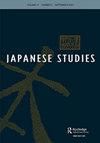The Land We Saw, the Times We Knew: An Anthology of Zuihitsu Writing from Early Modern Japan
IF 0.4
Q3 AREA STUDIES
引用次数: 1
Abstract
The land we saw, the times we knew: An anthology of zuihitsu writing from early modern Japan by Gerald Groemer is a virtual encyclopedia of Japanese culture in the Edo period (1603–1868). The anthology is a collection of seven zuihitsu, a genre of literature that does not have an exact equivalent in the West. It is sometimes translated as ‘essay’, but most zuihitsu are much longer than an essay in Western literature. Groemer introduces the reader to this genre by first attempting to pin down a precise meaning of the term zuihitsu. His starting point is the description of the genre as it has been understood by scholars up to now: zuihitsu is a written ‘record of what a writer has seen, heard, felt, understood, experienced, and noted, in the order in which it comes to mind, with no guideline, no plan, and no order’ (2). He then proceeds to bring the reader into the mind of the Japanese zuihitsu writer, who thinks of his work as coming less from his own creativity and more from the writing brush itself. The ‘notion that if only the writing brush were allowed to take the lead, its traces would directly and faithfully reproduce the truth of reality rather than the predispositions and illusion of the writer’ (2). One might say that for the writer of zuihitsu, it is the intuitive mind rather than the rational mind that is the source of the content of the work. The subjects with which zuihitsu deals are not only topics on popular culture. The works are rich in references to Chinese and Classical Japanese literature and history. The copious notes that Groemer provides explain in detail the origin and meaning of the literary allusions and historical and geographical references that allow the reader to become familiar with many of the key concepts of Edo-period religion and philosophy. Unlike many strictly academic textbooks, however, this anthology is as enjoyable to read as it is scholarly and would make an excellent text for a Japanese culture or world literature class for either undergraduate or graduate students. Groemer successfully meets the goals of a successful translator, as he describes this daunting task in the preface of the book:我们所看到的土地,我们所知道的时代——日本近代早期足利寿作品选集
我们所看到的土地,我们所知道的时代:杰拉尔德·格罗默(Gerald Groemer)撰写的近代早期日本的一种文字选集,是江户时代(1603-1868)日本文化的虚拟百科全书。这本选集收录了七首自诗,这是一种在西方没有完全等同的文学体裁。它有时被翻译为“随笔”,但在西方文学中,大多数定语都比随笔长得多。格罗默在介绍这一体裁时,首先试图确定“一击”一词的确切含义。他的起点是类型的描述,因为它已经被学者了解到目前为止:zuihitsu是书面的记录,一个作家所看到的,听到的,感觉,理解,经验丰富,并指出,在涉及到的顺序,没有原则,没有计划,没有秩序”(2)。然后,他继续把读者带进日本的头脑zuihitsu作家,他认为他的工作是更少的从自己的创造力和更多来自毛笔本身。“只要让毛笔带头,它的痕迹就会直接而忠实地再现现实的真相,而不是作者的倾向和幻觉”(2)。有人可能会说,对于“笔触”的作者来说,是直觉的头脑而不是理性的头脑是作品内容的来源。对打涉及的主题不仅仅是流行文化的话题。这些作品大量引用了中国和日本古典文学和历史。格罗默提供的大量注释详细解释了文学典籍以及历史和地理参考的起源和含义,使读者熟悉了江户时代宗教和哲学的许多关键概念。然而,与许多严格的学术教科书不同,这本选集读起来既有趣又学术性强,对于本科生或研究生来说,它将成为日本文化或世界文学课的绝佳教材。格罗默成功地实现了一个成功的翻译的目标,正如他在书的序言中描述的那样:
本文章由计算机程序翻译,如有差异,请以英文原文为准。
求助全文
约1分钟内获得全文
求助全文

 求助内容:
求助内容: 应助结果提醒方式:
应助结果提醒方式:


